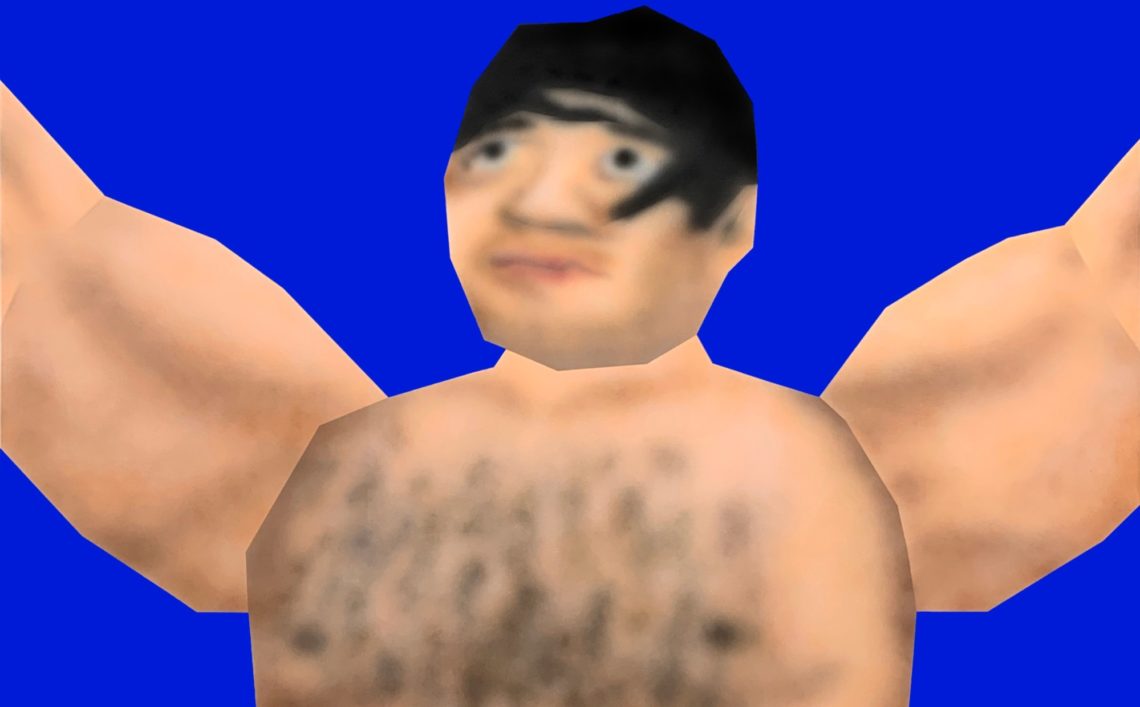The past always gets its revenge in the end.
Chinese-born, American-based painter Gao Hang creates art that aims to evoke awe and wonder towards images we’re now mostly just used to laughing at. His art channels the aesthetics of the late 90s, early 2000s virtual worlds of PlayStations, Nintendo 64s, and Sega Saturns, which back then were cutting-edge consoles. Their games were filled with characters with bizarre angular heads and pixelated faces, and Hang’s paintings depict the strange beauty of those 3D rendered, low poly worlds. The games might look like crap today, but at the time they felt utterly magical, an effect Hang revives on his canvas with an airbrush.
It’s not that Hang doesn’t think these worlds are funny; his artworks often have humorous titles like “Your uncle behind a wall” and “Dickless horse.” But he’s gesturing at something deeper: a moment in history when the sharp line between the real and the virtual was ever so subtly beginning to crumble—an era we’re becoming ever more nostalgic for as we descend deeper and deeper into ultra-realistic augmented seas of life, digitalized.
We caught up with the artist to chat about the process behind his images, how Counter-Strike changed his life, and why he has a soft spot for simulation theory.
VICE: Hey Gao, how would you describe your style and approach to art?
Gao: I depict low poly, early 2000s video game characters—that’s what they’re based on. I’m trying to recreate the impact I felt in my childhood. I’m 35, so I was ten in the early 2000s—the age when you’re starting to formulate your understanding of the structure of the world. I’d been playing 2D games on the Nintendo, and then all of a sudden came Counter-Strike, a 3D game. It really hit me: to my childhood self, the world inside it could not be more real. It had a visual, physical, and psychological impact on me that is still lasting until now. It was like a singularity moment. By comparison to the 2D games I’d played before, in a 3D game you move through time; you had community in that game, you had the laws of physics, you communicated with each other, you had a moral system. Everything that could define a world was there. And we were just kids, so to us it was like a parallel universe.
What made Counter-Strike so special in comparison to other 3D games of the era?
When you die [in the game] you become this ghost: you rise out of your body and look down on your dying self, and then you can float around to see what other people are up to. I liked to die really quickly and become this ghost, and then just float around, exploring the environments, approaching characters, and looking at their chin really closely, or getting really close to their eyes, and just being like, “Wow!” In hindsight, I think I was searching for a feeling of safety, because it all felt so incredibly real to me. I needed to go really close to see the rawness, the handmade, the imperfections, bugs, and flaws. I wanted to reassure myself that this was fake and not real.
How do these games inform the visual style of your paintings?
In those days, computer engineers were not typically artists, they were computer science engineers. So they did a lot of ‘mapping,’ where they just mapped photo-like images onto raw cubical structures. It looked so funky, but so real. Counter-Strike is one of the best examples, but I paint lots of different characters or subjects from that era, the early 2000s. It was a time when video game characters sort of looked like someone, but also looked like everyone.
How does one of your paintings come together?
Every work is kinda different. I have an emulator now so I can emulate these old games, or I can watch other people play through them on YouTube. And then some scene will catch my attention and I screenshot it, put it in Photoshop, change the background, change the shape of the person, blur some things, play with composition, and then I have several different visual effects that I use based on each image. Then I will close that Photoshop, put that picture up in my studio, and just start painting. Before artists used to paint still lifes and landscapes—now we paint screens.
I’ve read that you mostly use an airbrush tool. Why does an airbrush lend itself so well to painting scenes that look like they’re rendered in old computer graphics?
The airbrush is a very delicate tool. You can adjust airflow and how much paint you want mixed in. I found it interesting because it’s so blurry when you use it far away. If you combine the technique of hard edges (I tape the edge first to mask the rest of the canvas) and then airbrush, you end up with this really sharp blurriness.
That seems like a contradiction, right—how can something be sharp and blurry? But isn’t that exactly what we see when we look closely at these 3D characters? Their edge is super sharp, separated from the background so clearly, but what’s inside them is blurry. It’s like a super high-def blurriness. So that’s what I’m trying to achieve.
There seems to be a thirst in the air to revisit this period of 2000s virtual aesthetics. Why do you think that is?
If you look at art history, technological singularities always trigger artists to do different things. In the early 20th century, futurism was triggered by the advent of fast planes, fast trains, and big machines—it was all about speed. Then you had World War II, and the postwar paintings of Pollock and Rothko, etc, because: Who had the patience to do all that neat stuff anymore? War was about the primal. Then you had something similar in the advertisement era and the rise of pop art. I think every era has its own singularity moment that it can’t avoid talking about. To me, it’s now the 3D world, the parallel universe. It’s the start of that.
What fascinates you about this blurring of the line between what is real and what is virtual or simulated?
I’m interested in simulation theory, a concept drawn from Jean Baudrillard and Nick Bostrom. But it’s something people have been thinking about for a long time: in Ancient China, Zhuangzi woke from a dream about being a butterfly and wondered whether he was a man dreaming that he was a butterfly or a butterfly dreaming that it was a man. If you meditate, you get that feeling sometimes. I meditate every day and, while I’ve not had that out of body experience yet, I think I’m getting there. When you really concentrate on something purely, everyone feels really far away somehow.
How does this interest in simulation theory penetrate your art?
It’s like cave painting. A cave painting is a clue of a civilization. The cave painting itself is so raw, but it’s the start of something, the start of a culture. My painting is the same thing. I’m painting the first generation of 3D characters. In the future, we’ll be engaging with 3D characters that are so real that we can barely tell if they’re in the real world or not, and neither can they. I’m painting the first generation of that; the starting point of this new civilization. People who like my paintings don’t need to know this, but this is what I’m thinking about.
So what you’re saying is that you see the 3D graphically rendered characters of 90s and 2000s video games as the beginning of a process that will eventually lead to sentient virtual beings, and what you’re painting is the cave paintings of these beings?
Yes.
Gao Hang’s solo show ‘Screen: Life Drawing’ will be at Tang Contemporary Art, Beijing, from April to June
The post Gao Hang’s Paintings Honor the Deranged Beauty of Old N64 and PS2 Games appeared first on VICE.




